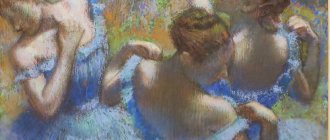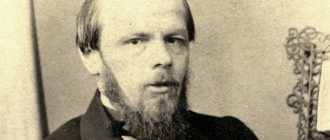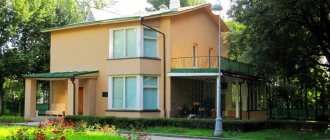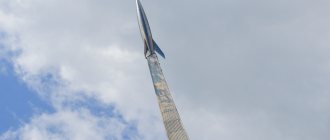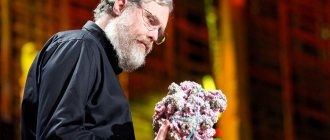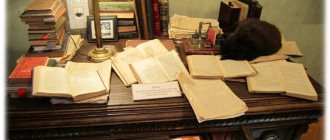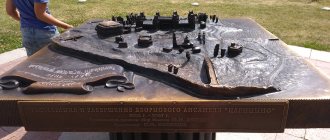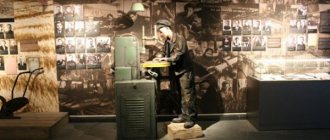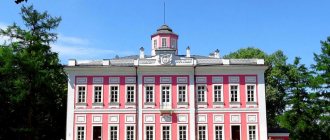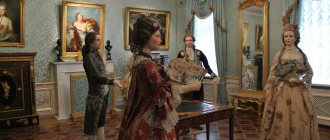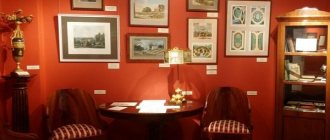History of the A. Rublev Museum
The monastery was founded in 1356; many heroes of the Kulikovo Field are buried there. The icon of the Most Holy Theotokos of Vladimir shone here; it is believed that it was she who saved Moscow from Tamerlane’s raid. The cathedral is well fortified with massive walls, behind which the townspeople more than once took refuge during enemy attacks.
In the 18th century, a bell tower was built in the monastery, the second tallest after the Kremlin’s Ivan the Great, but it was blown up in the 30s, when they decided to fight the churches. Approximately the same fate awaited the monastery itself, but quite unexpectedly, scientists found frescoes by Andrei Rublev on the walls of the cathedral. They suffered greatly; as it turned out later, during Napoleon’s raid, a significant part of them was lost forever. But what was left was enough to save the cathedral from demolition - this is how the icon painter helped the monastery that sheltered him. In 1947, on the rise of patriotism that reigned after the war, it was decided to create the Andrei Rublev Museum. In the Andronikov Monastery, the exhibition began to work only in 1960, on the 600th anniversary of Andrei Rublev.
Present of the Museum
In the 21st century, the establishment continues to operate intensively. Numerous events and exhibitions take place here. Every year the conference “Dialogue of Cultures. Russia-Georgia". In addition, there are always demonstrations of new works that have replenished the institution’s stock: after restoration, visitors can always get acquainted with icons or other objects. One of these works, the manuscript “The Ladder,” the author of which was the scribe Ferapont, was recently shown in one of the museum halls. Periodically, the museum hosts exhibitions of icons from private collections.
In the year of the 70th anniversary (2017), the exhibition of the institution was replenished with new exhibits that were previously under restoration. Thanks to this, museum visitors were able to see over 300 objects. Another new exhibit has also appeared - a tombstone. It was discovered on the territory of the monastery. The date of manufacture of the tombstone is 1543. Judging by the inscription, the slab was installed on the grave of the monk Vassian Rakov.
Museum exhibition
Now the Andrei Rublev Museum is the largest icon painting museum in the world. The image of the Savior Not Made by Hands has been considered the main shrine in the Andronikov Monastery for many centuries. This icon is priceless; it has been in the cathedral almost from the very foundation of the church. The next most important exhibit is a masterpiece by Andrei Rublev, the icon of John the Baptist. The figure of the saint is filled with unearthly sadness and calm. The viewer gets the impression that the prophet knows about the fate prepared for him. The icon was painted so talentedly that even time could not reduce its impact on the viewer. The Prophet is eye-catching despite the cracked wood and faded paint.
The Rublev Museum also houses an exact copy of the famous Rublev “Trinity”. A non-specialist will not be able to distinguish a copy from the original. There are many icons on the theme of the Trinity. Rublev wrote a popular story like no one else. This can be confirmed by comparison with other icons; some of them date back to an even earlier period. The museum also houses works by other masters, not only icons, but also frescoes, objects of applied church art, and wooden sculptures.
All church festivals are solemnly celebrated in the museums, lectures on the culture of Ancient Rus' and Byzantium are given, and on Sundays there are concerts of instrumental and sacred music. The Andrei Rublev Museum will be interesting for admirers of the icon painter’s talent, lovers of ancient Russian and Byzantine history, Orthodox Christians and simply curious people.
"Vector of spirituality"
- 29.11.2018
- Valery Lukyanenko
Vladimir d'Ar
This is not just a museum, but something more - it is a collection of the greatest and most valuable ancient Russian icons, the spiritual heritage of our people. This is how it is better to perceive what we will see. An icon is not just an image of saints or an attempt to depict God, it is a Window into another, as they say, the Invisible World, the world of Love, Acceptance, Faith, Repentance and Forgiveness. If you initially prepare yourself to perceive what you will soon see precisely from these positions, you will subsequently leave the walls of this museum renewed, filled with new strength, immense vital energy to accept this World as it is, you will see a new world that has opened up to you from the Other Side, from the side of infinite Light and Good, you will feel yourself having touched the Sources, evoking sublime and reverent feelings. Well, however, everyone has their own here, so let’s not go deeper and let’s take a look at the museum and its exhibitions.
I must say that it is definitely unrealistic to photograph all the works of ancient Russian art in the Rublev Museum, and is it really necessary!?) In general, we will see those icons, frescoes that attracted my attention and not only attention, but something that resonated within itself that cannot be expressed words. The photos from this museum are already quite old, from 2012 - then I was shooting exclusively with a Canon 5D II SLR camera and a number of photographs, of course, no longer reach the level reached by current photographic equipment with its advanced sensitive matrices. Well, this won’t hurt us at all, as I understand it. So, go ahead!
The museum was founded in 1947 by scientists Pyotr Baranovsky, Igor Grabar, Nikolai Voronin and Pavel Maximov, on whose initiative the restoration of the Spaso-Andronikov Monastery began. The official opening of the museum took place in 1960 and was timed to coincide with the 600th anniversary of the birth of icon painter Andrei Rublev. The collection consists of more than thirteen thousand items from a collection of icons from the 12th to 20th centuries, frescoes, wooden sculptures, as well as archaeological finds. The valuable collection of icon paintings of the 13th-17th centuries brought the Andrei Rublev Museum world fame. In 1991, it was included in the list of especially valuable objects of cultural heritage of the peoples of the Russian Federation.
Before entering the territory of the monastery, let us express our respect and respect to the talent of the legendary ancient Russian icon painter Andrei Rublev. Already in modern times, near the walls of the Andronikov Monastery (near the southwestern tower), a stone quadrangular chapel with cut corners was built under an octagonal dome. The chapel of the Life-Giving Trinity was consecrated on September 21, 2011. By the way, the 650th anniversary of the Spaso-Andronikov Monastery was celebrated in 2010.
The chapel is small, elegant and very beautiful. 03.
Inside the chapel there is a Florentine mosaic of Rublev’s “Holy Trinity”. The chapel was erected under the care of the Andrei Rublev Foundation. Architect Evgeny Katyshev. 04.
The mosaic “Trinity” by Andrei Rublev for placement in the Trinity Chapel was created by the outstanding Italian artist Mario Antonucci using ancient Florentine technology from precious and semi-precious stones with gilding elements. 05.
The original monument to Andrei Rublev by sculptor V.G. Lenskaya and architect E.V. Yavorsky was installed in the park in front of the Spaso-Andronikov Monastery back in 1967 for the 600th anniversary of Andrei Rublev. This small monument represents the figure of an icon painter who sits on a bench, holding in his outstretched hand a board with a drawing of the future icon. But in 1985 this monument was replaced by another. And this one was moved to the territory of the Novospassky Monastery. Somehow, for now, he doesn’t feel very comfortable there, it seemed to me. A pedestal obviously wouldn't hurt him. 06.
On the main alley leading to the Holy Gates of the monastery, in 1985, a new monument was erected to Andrei Rublev, the most famous and revered Russian icon painter of the Moscow school of icon painting, book and monumental painting of the 15th century, a monk of this monastery by the famous sculptor Oleg Konstantinovich Komov. It is considered to be more successful artistically. 07.
I posted below another photograph of this monument (with a view of the Holy Gates) because I considered it symbolic of those who had taken a fancy to the monument to the icon painter at the time of this shooting) What’s interesting is that the dove on the head of the sculpture continuously and for quite a long time rotated around its axis clockwise - I’ve never seen this before) 08.
I note that there is another Komovsky monument to Andrei Rublev in Vladimir. The monument was opened in August 1995 for the 1000th anniversary of the city. However, we should go to the Rublev Museum)
Collection of the Rublev Museum
began to take shape in 1954 with the first scientific expeditions of museum workers, which were aimed at compiling an inventory of Russian monasteries and a list of damaged icons. The first five works came from the Local History Museum of the city of Vladimir and were selected from those works that, in the opinion of the local leadership, were subject to destruction. The second valuable import occurred in 1955, when works were transferred from the Euthymius Monastery in Suzdal. At the time of the official opening of the museum in 1960, the collection consisted of 317 art objects. In subsequent years, the museum space was actively replenished: from 1970 to 2000, the repository increased significantly due to gifts from private individuals and government organizations. As of 2021, the exhibition contains more than 13 thousand items: icons, archaeological finds, handwritten and early printed books, as well as originals and copies of frescoes. The main exhibition space is located in the Church of the Archangel Michael, built in the 17th century by order of the first wife of Peter I, Evdokia Lopukhina. 09.
Church of the Archangel Michael
The museum collection contains more than 4.5 thousand icons of the 13th-20th centuries. Among the rarest works are “Savior Almighty” of the 13th century, “Savior Not Made by Hands” of the 14th century, “John the Baptist” of the 15th century, “Archangel Gabriel”, as well as “The Blessed Princes Boris and Gleb” of the early 20th century. Also exhibited there are works made by craftsmen from Romanov-Borisoglebsk: drawings by master Afrikin Lisikhin, which depict images of the Virgin Mary, as well as a sheet of “The Savior of Romanovo-Borisoglebsk”. 10.
The main exhibition of the museum is located in the Refectory Chamber and the Church of the Archangel Michael. It occupies more than ten halls and introduces visitors to outstanding examples of artistic creativity of the 11th-17th centuries. eleven.
View of Moscow (former Rogozhskaya Sloboda) from the windows of the Church of the Archangel Michael (through double glass). 12.
The main mission of the museum is to help people discover the icon as one of the greatest achievements of national and world art, to “root” them in their own cultural tradition. In the thousand-year history of Russian art, the main part - seven centuries - falls on the pre-Petrine era, when artistic culture developed within the framework of a religious worldview.
Now let's examine the museum's exhibitions. There is no need to comment specifically on the works of ancient Russian art presented in this material; you will see and feel everything yourself. And therefore, I almost fall silent... 13.
Church of the Archangel Michael. Andrey Rublev Museum.
14.
Church of the Archangel Michael. Andrey Rublev Museum.
Of course, Andrei Rublev’s trinity is in the Museum, but it’s a copy, naturally. 15.
Trinity by Andrei Rublev. Copy.
Another work by Andrei Rublev “The Last Judgment. Flying Angel"
. Copy of the fresco. In 1956, David Arsenishvili (director of the Museum) suggested N.V. Gusev to make copies of the paintings of 1408 in the Vladimir Assumption Cathedral, created by the Monk Andrei Rublev and Daniil. This turned out to be timely, since the subsequent restoration of these Rublev frescoes is considered unsuccessful among experts. 16.
Andrey Rublev.
“The Last Judgment. Flying Angel." Copy. Icon of the Mother of God Hodegetria of Smolensk
17.
Icon of the Mother of God Hodegetria of Smolensk, Great Martyr George, with life.
First third of the 16th century Moscow school. 129.5 x 100.
Comes from the Pyatnitskaya Church in the city of Dmitrov.
Entered the Andrei Rublev Museum in 1959 from the Dmitrov Museum of Local Lore. 18.
Great Martyr George, with his life. First third of the 16th century
19.
Great Martyr George, with his life. Fragment.
20.
The famous miraculous icon of St. Nicholas of Zaraisk.
The famous literary monument of Ancient Rus' “The Tale of Nikola Zarazsky” (which, according to academician D.S. Likhachev, “belongs to the outstanding phenomena of ancient Russian literature”) talks about the bringing in 1225 “the image of the great Wonderworker Nikola Korsunsky from the glorious city of Chersonesos to borders of Ryazan, to the region of the blessed Prince Fyodor Yuryevich Ryazansky.” As the chronicles describe, the icon appeared in the city of Krasny (the future Zaraysk) on July 29 (old style) 1225 and since then St. Nicholas took the city and its inhabitants under his heavenly protection. 21.
Icon of St. Nicholas of Zaraisk
St. Sergius of Radonezh in his life
(Workshop of Dionysius, Theodosius (?). Beginning of the 16th century. 22.
Venerable Sergius of Radonezh in his life
Icon of the Dormition of the Virgin Mary. Dionysius.
Second half of the 15th century. Assumption Cathedral in Dmitrov. 23.
Icon of the Dormition of the Virgin Mary.
Dionysius. Second half of the 15th century. Trinity Life-Giving. 1484-1485. Elder Paisios.
Moscow school.
The icon entered the Museum. Andrei Rublev in 1954 from the Assumption Cathedral of the Joseph-Volokolamsk Monastery.
Restored by K.G. Tikhomirova and I.V. Vatagina in 1955 and 1975. Preservation: the clothes of the right (especially the chiton) and middle Angels, the halo of the right Angel have been significantly lost. On the clothes of the left and on the sleeve of the middle Angels, the author's painting has been lost. 24.
Trinity Life-Giving. 1484-1485. Elder Paisios.
Archangel Gabriel. From the Deesis rank. Tver.
Second quarter of the 16th century.
Restoration: Evseeva, Kochetkov, Sergeev 1974. Saltykov 1981. 131 × 59 cm.
25.
Archangel Gabriel. From the Deesis rank. Second quarter of the 16th century.
St. John the Baptist from the Deesis rite of the temple in the village of Obodovo, Tver region
. Tver school. Icon of the first half of the 15th century.
Restoration: Evseeva, Kochetkov, Sergeev 1974: Late XIV - early XV centuries. Saltykov 1981: Second half of the 15th century.
80.5 × 57.5 cm. 26.
St. John the Baptist from the Deesis rank of the temple in the village of Obodovo, Tver region.
Icon of the Mother of God from the village of Obodova. Tver school
. From the Deesis belt rank. Tver. First half of the 15th century. 80 × 57.5 cm. 27.
Icon of the Mother of God from the village of Obodova.
First half of the 15th century Archangel Gabriel. End of the 15th - beginning of the 16th centuries.
28.
Archangel Gabriel.
End of the 15th - beginning of the 16th centuries. Our Lady of the Deesis Order (Peacemaker)
Intercession wooden church in the village of Chernokulova, Yuryev-Polsky district, Vladimir region. Rostov-Suzdal school. Beginning of the 16th century 130 × 56 cm. 29.
Icon of the Mother of God from the Deesis rank (Peacemaker) Archangel Gabriel from the Deesis rank.
XV-XVI centuries End of the 15th - beginning of the 16th centuries. Rostov school. Author unknown. thirty.
Archangel Gabriel from the Deesis rank.
XV-XVI centuries Trinity Life-Giving. End of the 15th - beginning of the 16th centuries.
Tradition of the Trinity-Sergius Lavra. 145x116. Comes from the Trinity Church in the village of Divnaya Gora near Uglich. The icon was taken to the Andrei Rublev Museum by an expedition in 1964. Restored (not completely: notes on the wings remained, the meal was not fully revealed) by A.V. Kirikov in 1970 after the 1967 exhibition in the State Tretyakov Gallery. Condition: small scratches and abrasions all over the surface, the background is lost. 31.
Trinity Life-Giving.
End of the 15th - beginning of the 16th centuries. Saint Nicholas the Wonderworker. First half of the 15th century.
From the Kalinin Museum of Local Lore. 128 × 85 cm. Wood, tempera.
32.
Saint Nicholas the Wonderworker
Saint Nicholas of Myra, con. XV century Tver.
St. Nicholas of the 16th century, the blessing right hand was rewritten by the New Believers in “malaksa”, to the right of it the preserved ends of the original two fingers are visible. 33.
Saint Nicholas of Myra, con.
XV century Tver. Iconostasis of the Spaso-Evfimievsky Monastery in Suzdal. 1660s.
34.
Iconostasis of the Spaso-Evfimievsky Monastery in Suzdal. 1660s.
35.
Iconostasis of the Spaso-Evfimievsky Monastery in Suzdal. 1660s.
36.
Iconostasis of the Spaso-Evfimievsky Monastery in Suzdal. 1660s.
Iconostasis of the Church of the Annunciation in the city of Yuryevets (first third of the 18th century).
37.
Iconostasis of the Church of the Annunciation in the city of Yuryevets (first third of the 18th century)
38.
Museum of Ancient Russian Culture named after. Andrey Rublev
Reverend Neil Stolobensky. 2nd half XIX century Tver province.
39.
Venerable Neil Stolobensky / 2nd half. XIX century Tver province.
40.
Museum of Ancient Russian Culture named after. Andrey Rublev
Fragment of a fresco depicting the Archangel
41.
Museum of Ancient Russian Culture named after.
Andrey Rublev Fragment of a fresco depicting Archangel Michael
42.
Museum of Ancient Russian Culture named after.
Andrei Rublev Our Lady of the Burning Bush
17th century Volga region. From the Trinity Makaryev Monastery in Kalyazin. 43.
Our Lady of the Burning Bush
Our Lady of Vladimir. Around 1676
From the Pokhvalskaya Church in the village of Orel, Bereznikovsky district, Perm region. 44.
Our Lady of Vladimir.
Around 1676 Archangel Gabriel. End of the 17th century
45.
Archangel Gabriel.
End of the 17th century Our Lady of Jerusalem. 1710
46.
Our Lady of Jerusalem.
1710 Our Lady of Life-Giving Spring. 1703
Kirill Ivanov Ulanov. 170.5 × 116 cm. Wood, tempera. From the Church of the Archangel Michael in Bronnitsy (Moscow region). 47.
Our Lady of Life-Giving Spring.
1703 Saint Nicholas of Myra
48.
Saint Nicholas of Myra
Icon of the Gracious Sky.
(What shall we call you). 17th century Unknown author. Wood, pavoloka, gesso, tempera. 49.
Icon of the Blessed Sky.
17th century Our Savior of Smolensk with Saints Sergius and Barlaam
Second floor. XVII century From the Nativity of Christ Cathedral in Balakhna. 50.
Savior of Smolensk with Saints Sergius and Varlaam
Venerable Sergius of Radonezh. 17th century icon.
51.
Venerable Sergius of Radonezh.
17th century icon. Icon of the Savior in Strength
Third quarter of the 16th century. Central Rus'. 148 × 106 cm 52.
Icon of the Savior in Power
Elijah the Prophet in the desert. Belozerye (?). Second half of the 16th century.
53.
Elijah the Prophet in the desert.
Belozerye (?). Second half of the 16th century. Saint Nicholas the Wonderworker (Zaraisky) with his life.
Second half of the 16th century. Vologda lands. 54.
Saint Nicholas the Wonderworker (Zaraisky).
Archangel Michael, with deeds. XVI century. Veliky Ustyug.
From the Church of the Assumption in Lyalsk, Kirov region. 55.
Archangel Michael, with deeds.
XVI century. Veliky Ustyug. Martyrs Cosmas and Damian, Apostle James, Brother of the Lord.
First half of the 16th century 56.
Martyrs Cosmas and Damian, Apostle James, brother of the Lord.
Descent into hell. XVI century.
In ancient times, the icons of the “Descent into Hell” - they were not called that, they were, in fact, icons of the Resurrection of Christ. Hell here is represented as defeated and powerless. Angels are busily binding demons with chains... 57.
Descent into hell.
XVI century. Nikola Zaraisky with his life. 1552
58.
Nikola Zaraisky with his life.
1552 Royal Doors (Basily the Great and John Chrysostom).
Second quarter of the 16th century. Author unknown. Disclosed by A.B. Kirikov in 1960-1961 at the Central Museum of Ancient Russian Culture and Art named after. Andrey Rublev. The gate leaves are sawed off at the top and bottom; the finial has not been preserved. On the front side there are slight differences in the level of the boards at the joints. Minor scuffs and scuff marks on the paint layer. Size: 102 x 44.5 cm (left door); 101 x 44 cm (right door). 59.
Royal Doors (Basily the Great and John Chrysostom).
Saint Nicholas the Wonderworker, Venerable Anthony the Great and Athanasius of Athos. XVI century
60.
St.
St. Nicholas the Wonderworker Anthony the Great and St. Afanasy Afonsky. Icon of the 16th century. Saint Nicholas of Myra with the appearance of the Mother of God Rev. Sergius of Radonezh
(at the top of the icon on the left) and selected saints. 61.
Saint Nicholas of Myra.
John the Baptist. XVI century
From the iconostasis of the Trinity Church of the Makhrishchi Monastery. 62.
John the Baptist.
XVI century from the iconostasis of the Trinity Church of the Makhrishchi Monastery. Icon “Our Lady of Tikhvin” 1550s
years from the Assumption Cathedral in Dmitrov, Moscow region. It is remarkable in that instead of the “classic” gold background it has an unusual azure background. 63.
Our Lady of Tikhvin
Saint Nicholas of Myra
The icons “Our Lady of Tikhvin” and “St. Nicholas of Myra” from the 1550s from the Assumption Cathedral in Dmitrov, Moscow Region, are remarkable in that instead of the “classical” gold background they have an unusual azure background: 64.
Saint Nicholas of Myra,
Our Lady of Tenderness. 1560s
65.
Our Lady of Tenderness. 1560s
66.
67.
Photos by Vladimir d'Ara (Discussion in LiveJournal)
Tags: History, Russia, Russia, photo report Categories: Library, Art, Main sections, Religions of the world
How to get there
The museum is located on the territory of the Tagansky district on Andronevskaya Square, house No. 10. You can get to the establishment:
- By public transport. There are trams No. 45, 40, 43, 20, trolleybus No. 53, buses N4, M8 that go to the Andronevskaya Square stop. You can also get to the museum by buses No. 730 or No. 125 - the stop is located next to the museum and bears the same name.
- Route taxi No. 199.
- Taxi, ordering a car through the service Taxi Lucky, Gett, Maxim, Yandex. Taxi or others.
- Metro. Take the Kalininskaya line to the station. "Ilyich Square". Next, one stop by bus No. M8, H4, 40, 125, 730. You will also have to pass one stop if you take tram No. 53, if you take the Lyublinsko-Dmitrievskaya line to the station. "Roman". Next you need to travel 2 stops by bus No. 40.
Excursions
To ensure that each visitor can choose the most suitable option for viewing the exhibition, the museum staff provides various services:
- Group excursions for groups of more than 5 people in Russian or English.
- Various types of excursions are organized - sightseeing, extended, with the opportunity to get more information on a particular topic. There are excursions dedicated to the monastery complex itself, the history of the Russian iconostasis, and ancient Russian painting.
- Individual excursions for groups of less than 5 people.
- Excursions for schoolchildren.
- Tours of temporary exhibitions.
